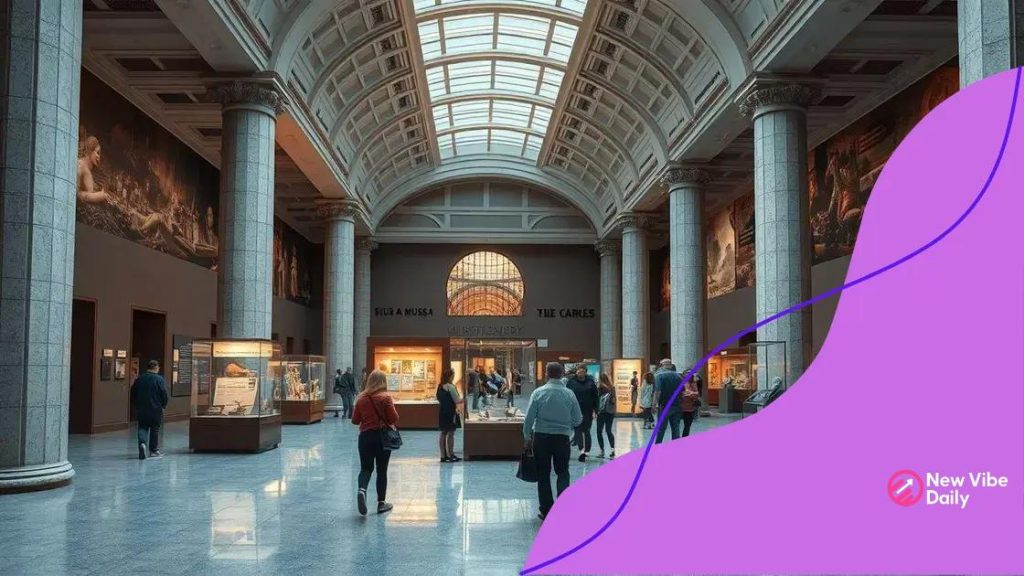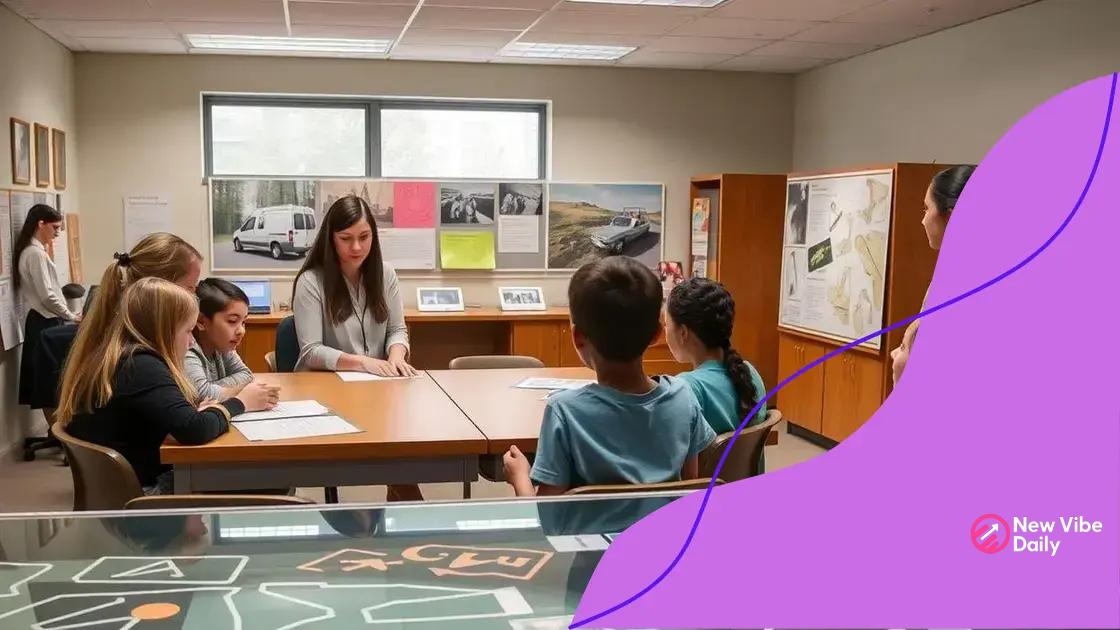The role of museums and cultural institutions in education

The role of museums and cultural institutions in education is to enhance learning by providing interactive experiences that engage students, foster creativity, and bridge the gap between theoretical knowledge and practical application.
The role of museums and cultural institutions in education is often underestimated. Have you ever thought about how a visit to a museum can spark curiosity and deepen understanding? Let’s explore their significant impact on learning.
Understanding the impact of museums on learning
Museums play a crucial role in the learning process. They offer an interactive experience that enhances traditional education methods. When students visit a museum, they engage with exhibits that bring history and science to life. This hands-on approach not only makes learning fun but also promotes critical thinking.
Benefits of Museum Learning
Visiting museums can significantly enrich student education. Here are some of the benefits:
- Experiential Learning: Students learn by doing, which helps improve retention of information.
- Cultural Awareness: Museums expose students to diverse cultures and histories, fostering appreciation and understanding.
- Enhanced Curiosity: Interactive displays promote questions and exploration, making learning more engaging.
As students interact with different artifacts and exhibitions, they not only absorb knowledge but also develop skills like observation and analysis. These experiences support the curriculum while also allowing students to explore topics in depth.
Engagement through Technology
Modern museums are increasingly utilizing technology to enhance learning. Interactive apps and virtual tours have made it easier for students to access information from anywhere. This change allows for an interactive experience even when in-person visits aren’t possible.
Furthermore, museums often partner with schools to create tailored educational programs. These partnerships can include workshops and guided tours that align with the school’s curriculum. Such collaboration makes museum visits directly relevant to what students are learning in the classroom.
In summary, understanding the impact of museums on learning reveals their importance in education. They serve as dynamic learning environments that cater to various learning styles. By integrating museum resources into education, teachers can inspire a new generation of learners who appreciate culture and history.
How cultural institutions foster creativity
Cultural institutions, such as galleries and theaters, play a vital role in fostering creativity among individuals. By showcasing a wide range of artistic expressions, they inspire visitors to think outside the box. Experiencing art in various forms not only sparks imagination but also encourages innovation.
Promoting Creative Thinking
Cultural institutions encourage creative thinking through interactive exhibits and workshops that engage audiences. Visitors have the opportunity to explore concepts in new ways, allowing them to connect ideas creatively. Here are some ways they promote creative expression:
- Workshops: Many institutions offer hands-on activities where individuals can create their artwork, allowing for personal expression.
- Exhibitions: Curated displays challenge visitors to interpret art from different perspectives.
- Collaborative Projects: Programs that involve community collaboration foster creativity by encouraging teamwork and diverse ideas.
As attendees explore various artistic mediums, their minds open to new possibilities. This exposure cultivates an appreciation for creativity that can translate into everyday life.
The Role of Technology in Creativity
Technology has also changed how cultural institutions foster creativity. Virtual reality and interactive displays allow visitors to engage with art in innovative ways. By incorporating digital tools, institutions attract a younger audience keen on exploration. These experiences not only entertain but also challenge traditional forms of art presentation.
Cultural institutions encourage dialogue through artist talks and panel discussions. This exchange of ideas pushes audiences to think critically about artistic works. Engaging with artists directly provides insight into their creative processes, encouraging visitors to articulate their own thoughts on art.
In essence, the impact of cultural institutions on creativity is profound. By providing diverse experiences, they inspire individuals to unlock their creative potential. Engaging with art opens pathways to innovation, making cultural institutions essential for nurturing creativity.
Engagement strategies for educators and museums

Collaboration between educators and museums is essential for enhancing student learning. When teachers partner with museums, they create engaging experiences that enrich the curriculum. This approach helps students connect classroom lessons with real-world applications.
Creating Collaborative Programs
One key strategy is developing collaborative programs that align educational goals with museum resources. Programs can include:
- Curriculum-Based Workshops: Tailored workshops help students explore subjects in depth, bringing lessons to life through hands-on activities.
- Field Trips: Well-planned visits where students actively participate can deepen understanding and retention of knowledge.
- Virtual Learning Experiences: Offering online resources and virtual tours allows educators to incorporate museum content in their teaching, making it accessible to all.
Such collaborations increase student engagement and help foster a love of learning. Engaging with the community through museums also enriches the educational experience by offering diverse perspectives.
Interactive Learning Activities
Museums often provide interactive learning activities that encourage critical thinking and creativity. These activities can take many forms, such as:
- Hands-On Exhibits: These exhibits invite students to touch and interact, enhancing their understanding through experience.
- Creative Projects: Projects that allow students to create art, presentations, or research based on museum exhibits can deepen their engagement.
- Discussion Panels: Inviting students to participate in discussions with curators and artists fosters dialogue and inspires ideas.
These strategies are vital for maintaining a dynamic educational environment. They not only enhance student learning but also build a bridge between academia and the arts, enriching both fields.
Ultimately, by employing these engagement strategies, educators and museums can work together to cultivate an educational experience that is both enjoyable and impactful. This partnership leaves a lasting impression, encouraging lifelong learning in students.
Collaboration between schools and cultural institutions
Collaboration between schools and cultural institutions is essential for enhancing student learning experiences. When schools partner with museums, theaters, and art centers, they create unique opportunities for students to engage with real-world content. These partnerships bridge the gap between theoretical knowledge and practical application.
Benefits of Collaboration
Partnering with cultural institutions provides numerous benefits that extend beyond the classroom. Some advantages include:
- Access to Resources: Schools gain access to a wealth of resources, including expert knowledge, artifacts, and artistic materials.
- Enriched Curriculum: Integrating cultural content helps teachers connect lessons to broader contexts, enhancing student understanding.
- Community Engagement: Such partnerships foster a sense of community and belonging, encouraging students to become active participants in their education.
These partnerships not only enrich the curriculum but also motivate students to learn in interactive and engaging ways. As students participate in these experiences, they develop a deeper appreciation for arts and culture.
Creating Successful Partnerships
To establish effective collaborations, schools and cultural institutions should focus on communication and shared goals. Regular meetings between educators and cultural leaders can help identify resources that cater to students’ needs. This collaboration fosters creativity and innovation, benefiting both parties.
Furthermore, schools can design programs that fit within the cultural institution’s offerings, such as workshops that align with specific exhibitions. This ensures that students receive relevant and applicable learning experiences that enhance their curriculum and inspire new interests.
In summary, collaboration between schools and cultural institutions creates a dynamic educational environment that supports student growth. By working together, both entities can cultivate a love for learning and appreciation for cultural experiences.
Future trends in museum education
The future of museum education is evolving rapidly, driven by technology and changing educational needs. Museums are increasingly becoming dynamic spaces for learning, combining traditional exhibits with innovative educational practices.
Integration of Technology
One major trend is the integration of technology into museum experiences. Museums are utilizing virtual reality (VR) and augmented reality (AR) to create immersive learning environments. These technologies allow visitors to interact with exhibits in ways that were not possible before. For instance:
- Virtual Tours: Museums are offering virtual tours that broaden access to people who cannot visit in person.
- Interactive Apps: Mobile applications enhance the visitor experience by providing real-time information and interactive content.
- Online Learning Resources: Museums are developing online platforms where students can access lessons and activities anywhere, anytime.
These technological advancements make learning more engaging and accessible for diverse audiences.
Emphasis on Lifelong Learning
Another trend is the focus on lifelong learning. Museums are not just for school field trips; they are valuable resources for people of all ages. This emphasis encourages museums to offer programs that cater to adults and families, such as workshops, lectures, and interactive experiences. By attracting a broader audience, museums foster a culture of continuous education. This approach encourages communities to engage with art and history more deeply.
Additionally, museums are increasingly collaborating with schools to create curriculum-connected programs. These partnerships help align museum resources with classroom learning, making education more relevant and stimulating. As educators and museum professionals work together, they can design unique learning experiences that resonate with students.
In the future, as museum education continues to adapt, we can expect more creative and inclusive approaches that enhance the learning experience for all visitors. By embracing new technologies and fostering a commitment to lifelong learning, museums will remain at the forefront of educational innovation.
FAQ – Frequently Asked Questions about Museums and Cultural Institutions in Education
How do museums enhance the learning experience for students?
Museums provide interactive and engaging exhibits that connect classroom lessons to real-world applications, enriching the education process.
What role does technology play in museum education?
Technology, such as virtual reality and interactive apps, enhances visitor engagement and makes learning more accessible and enjoyable.
How can schools collaborate with cultural institutions?
Schools can partner with museums to create curriculum-based workshops, field trips, and virtual programs that align with educational goals.
What are the benefits of lifelong learning through museums?
Museums promote lifelong learning by offering programs and resources for all ages, encouraging community engagement and appreciation for culture.






